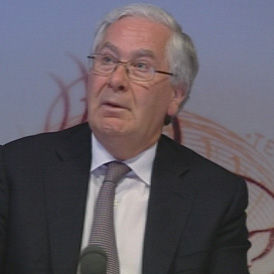Bank of England: zero growth expected in 2012
The UK’s economy is not expected to grow at all in 2012 and it will take an “Olympic” effort and hard work to battle the eurozone crisis, domestic deficit-cutting and tight credit conditions.

The Bank of England cut its 2012 growth forecast to zero today in its quarterly Inflation Report, compared to an expectation of 0.8 per cent growth three months ago. The forecast for medium-term growth was also slashed, with Britain’s economy now expected to grow 2 per cent by 2014 instead of around 2.5 per cent anticipated in May.
“The overall outlook for growth is weaker,” Bank Governor Sir Mervyn King said, adding that Britons will have to be “patient” while the bank works to “rebalance” the UK economy. Sir King urged Britons take take inspiration from the Olympic athletes to cope with a recovery that could be long in the making.
“The underlying picture is that output has been at best broadly flat over the past two years” and has continually disappointed expectations of a recovery, he said.
Flatlining
The downbeat gross domestic product forecasts differ from past years which have usually shown strong rebounds in growth, even after short-term weakness. Britain’s economy entered its second recession in four years at the end of 2011 on the back of austerity measures and the eurozone economic crisis. Instead, the UK’s economy is flatlining, figures released today show.
Sir King indicated his support for Prime Minister David Cameron’s austerity measures, however. When asked if the government should have a “plan B” for the economy, King said “no.”
‘Erratic factors’
The economy shrank 0.7 per cent in the second quarter of 2012 – the most in more than three years – made worse by wet weather and an extra public holiday.
The central bank said “erratic factors” exaggerated the weakness.
“Much of the contraction in the first half of this year reflects unusually large declines in measured construction output,” the report said. “Falls of that magnitude appear out of line with industry surveys and seem unlikely to persist.”
Britain may see a boost from the Olympic Games revenue in the third quarter, however, along with real income growth as a result of lower inflation, asset purchases and the Funding for Lending Scheme. As part of its “rebalancing”, the Bank has committed to buy a further £50bn British government bonds in the next four months, taking the total to £375bn. The UK has also announced a Funding For Lending scheme to provide cheap financing to banks who lend to home-buyers and businesses.
“The door is clearly open to more stimulus and we still expect both more quantitative easing and a further interest rate cut in November,” said Vicky Redwood, chief UK economist at Capital Economics.
Quantitative easing
The Bank’s quantitative easing programme essentially means printing more money despite the risks it could pose to inflation.
In what might be considered a bright spot amid the doom and gloom, inflation has fallen substantially since September 2011, when it hit a three-year peak of 5.2 per cent. It dropped to 2.4 per cent in June and inflation is forecast to fall again by the end of 2012, averaging below 2 per cent from late 2013 onward. The euro zone debt crisis remained the key risk for Britain’s economy, however.
Exports fell due to slowing global demand and the pound’s appreciation against the euro in the last year. If the gains were to continue, “it could make it harder for British producers to compete in world markets,” the central bank said.
Today’s projections are based on the bond target staying at £375bn and an interest-rate reduction by the second quarter of 2013, according to forecasts published in the report.
‘Erratic factors’
The economy shrank 0.7 per cent in the second quarter of 2012 – the most in more than three years – made worse by wet weather and an extra public holiday.
The central bank said “erratic factors” exaggerated the weakness.
“Much of the contraction in the first half of this year reflects unusually large declines in measured construction output,” the report said. “Falls of that magnitude appear out of line with industry surveys and seem unlikely to persist.”
Britain may see a boost from the Olympic Games revenue in the third quarter, however, along with real income growth as a result of lower inflation, asset purchases and the Funding for Lending Scheme. As part of its “rebalancing”, the Bank has committed to buy a further £50bn British government bonds in the next four months, taking the total to £375bn. The UK has also announced a Funding For Lending scheme to provide cheap financing to banks who lend to home-buyers and businesses.
“The door is clearly open to more stimulus and we still expect both more quantitative easing and a further interest rate cut in November,” said Vicky Redwood, chief UK economist at Capital Economics.
Quantitative easing
The Bank’s quantitative easing programme essentially means printing more money despite the risks it could pose to inflation.
In what might be considered a bright spot amid the doom and gloom, inflation has fallen substantially since September 2011, when it hit a three-year peak of 5.2 per cent. It dropped to 2.4 per cent in June and inflation is forecast to fall again by the end of 2012, averaging below 2 per cent from late 2013 onward. The euro zone debt crisis remained the key risk for Britain’s economy, however.
Exports fell due to slowing global demand and the pound’s appreciation against the euro in the last year. If the gains were to continue, “it could make it harder for British producers to compete in world markets,” the central bank said.
Today’s projections are based on the bond target staying at £375bn and an interest-rate reduction by the second quarter of 2013, according to forecasts published in the report.